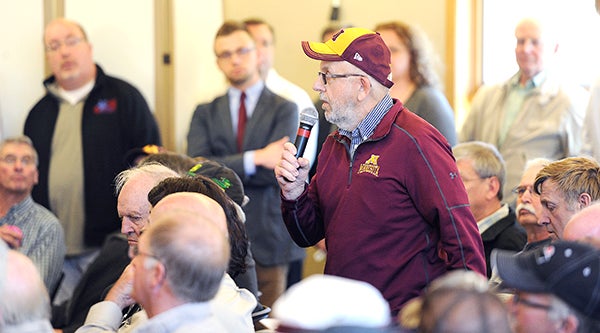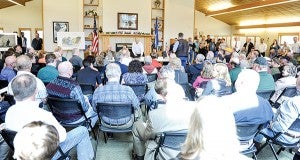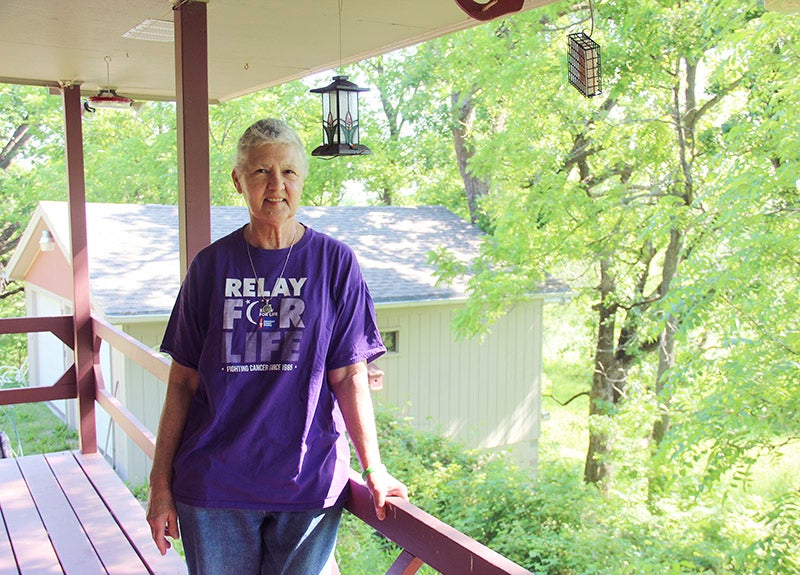Farmers offer mixed review of Dayton’s buffer plan
Published 10:54 am Friday, April 3, 2015

Mark Novak, a farmer near Wells, speaks on Gov. Mark Dayton’s proposed water buffer plan during the governor’s stop in Austin at the Jay C. Hormel Nature Center Thursday afternoon. – Eric Johnson/Albert Lea Tribune
AUSTIN — Gov. Mark Dayton stopped in Austin Thursday to hear solutions from farmers and landowners alike on a proposed water quality bill to add more buffer strip land throughout the state.
More than 200 people gathered at the Jay C. Hormel Nature Center Thursday afternoon to weigh in on legislation to require 50-foot buffer strips around Minnesota’s water systems.
Under a bill before legislators, landowners would have to install at least 50 feet of perennial vegetation — also known as a buffer strip — to help filter phosphates, nitrates, sediments and other potential pollutants from water running into the state’s rivers, lakes and streams.

Gov. Mark Dayton listens to a commentator during a forum on the governor’s proposed buffer strip plan at the Jay C. Hormel Nature Center Thursday. – Eric Johnson/Albert Lea Tribune
Dayton, along with various local and state officials, told the audience the proposal is meant to stem increasing water pollution concerns, especially after a recent Minnesota Pollution Control Agency report showed all but one out of 97 streams weren’t suited to drink or to use in water activities.
“It’s everybody’s problem and it needs to be everybody’s solution,” Dayton said.
Dayton’s proposal would add about 125,000 acres of buffer-stripped land throughout the state. Though there are several exceptions to the bill — beaches would be exempt from the buffer strip requirement, for example — some landowners and farmers were concerned the legislation would provide a one-size-fits-all solution to a complex problem.
Mark Novak, a farmer near Wells, said he already had about 33 feet of buffer strip lining his land near the ditches.
“With 33 feet, very little water from my land is going into the ditch,” he said. “You want me to add another 15 feet?”
Bruce Peterson, president of the Minnesota Corn Growers Association, defended the state agricultural industry’s track record on water runoff and said many farmers and agricultural companies are improving water quality through better technology and farming practices.
“I simply believe that one size does not fit all,” he said.
Yet farmers disagreed over whether buffer strips were necessary. One farmer said buffer strips on his land had helped filter rain water on his property since the 1970s, while another farmer said the government was, in essence, stealing several acres of his land that could be used for crops.
Mower County Farm Bureau President Marlin Fay called on Dayton and state officials to slow momentum on the bill until more research could be done, but Dayton said he would stand firm on getting water quality solutions like the buffer strip bill passed sooner than later.
“The fact is, things are not getting better, they’re getting worse and more polluted,” Dayton said.
After the meeting, Dayton said state officials could look into several measures proposed by the audience, which included more funding for soil and water conservation districts and reduced taxes on buffer strip land.

The Ruby Rupner Auditorium at the Jay C. Hormel Nature Center was filled to capacity Thursday afternoon as Gov. Mark Dayton held a forum on his proposal adding water quality buffer strips to ag land. – Eric Johnson/Albert Lea Tribune
Richard King, who owns farm land near Windom Township, said he supported the buffer strip proposal as well as a negative tax for the subsequent acres affected by the bill.
“If you put a negative tax on the buffer zone, they’re going to go for it more,” he said.
Dayton stopped in Worthington as well Thursday to discuss the proposal. Lawmakers will debate Dayton’s measure, as well as several other environmental proposals, over the next few weeks.
The visit came after District 27A Rep. Peggy Bennett, R-Albert Lea, hosted a listening session last month in Blooming Prairie to hear input about the proposal.
Bennett, who was out of town visiting family in Wisconsin, said she, too, supports efforts to improve water quality and to protect the state’s lakes, rivers and streams.
“I remain open-minded about the governor’s plan but still have concerns about a number of the plan’s components,” Bennett said.
Particularly, she is concerned about the “one-size fits all” nature of the program, as well as the loss of productive acres of farmland.
“I will continue to monitor the proposed buffer legislation and keep in close contact with the agricultural community to ensure any plan that is passed by the Legislature adequately addresses the various concerns raised about the plan,” she said.





